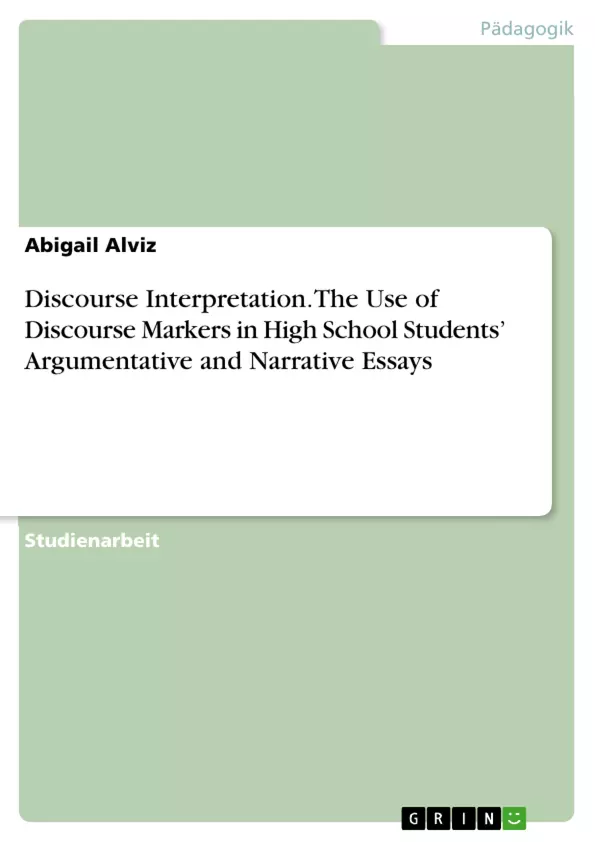Writing, as a macro skill, has been a central focus in most Philippine curricula in the last three decades and continues to be so. Filipino students are taught varied strategies on how they can improve their writing to produce well-organized texts. Specific writing devices are needed to help students formulate cohesive and coherent texts. Several studies have aimed at analyzing these devices, generally termed as discourse markers (DMs), which were considered as “growth market in linguistics” by Fraser (1998). DMs were first dealt in a seminal paper by Halliday and Hassan (1976) when they analyzed text and questioned: “What makes a text different from a random collection of unrelated sentences?”
Although the direct use of the term DMs was not mentioned, Halliday and Hasan, proposed a set of cohesive devices (reference, repetition, substitution, ellipsis, and conjunction) that “help create a text by indicating semantic relations in an underlying structure of ideas.” Fraser (2009) found that several expressions are used to refer to DMs including cue phrases, discourse connectives, discourse markers, discourse operators, discourse particles, pragmatic expressions, and pragmatic markers.
DMs are linguistic items such as well, however, so, because, etc. which contribute to the cohesiveness, cohesion, and meaning in discourse segments. Fraser (1990) provided an account of DMs to clarify their status and defined DMs as “a class of lexical expressions drawn primarily from the syntactic classes of conjunctions, adverbs, and prepositional phrases.”
In analyzing DMs, two accounts have emerged to which researchers subscribe. The issue highlighted in this difference is regarded to “how the use of DMs contributes to discourse interepretation”
The current study seeks to identify, quantify, and analyze the use of DMs in high school students’ argumentative and narrative essays. It also intends to probe into the relationship of the frequency and use of DMs to the quality of the students’ writing, Specifically, it would answer the following:
1. What types of discourse markers are utilized by Grade 9 Filipino ESL learners in personal narrative and argumentative writing?
2. Are there any significant quantitative and qualitative differences in the use of discourse markers by Grade 9 Filipino ESL learners?
3. Is there a direct relationship between the number of discourse markers used and the quality of students’ writings?
Inhaltsverzeichnis
- Introduction
- Research Questions
- Theoretical Framework
- Fraser's taxonomy of discourse markers
- Methodology
- Participants
- Corpus
- Procedure
- Interrater
- Results
- Quantitative Results
- Quantitative Differences
- Writing Quality
- Qualitative Results
- Lack of Sentence Combination Techniques
- Incorrect use of DMs
- Unnecessary use of DMs
- Initial positioning of DMs
Zielsetzung und Themenschwerpunkte
Die Forschungsarbeit zielt darauf ab, die Verwendung von Diskursmarkern in argumentativen und narrativen Aufsätzen von Filipino ESL-Lernenden der 9. Klasse zu untersuchen. Es werden die verschiedenen Arten von Diskursmarkern analysiert, die von den Lernenden verwendet werden, sowie die Auswirkungen dieser Verwendung auf die Kohäsion und Kohärenz der Texte.
- Die Rolle von Diskursmarkern in der Textkohäsion und Kohärenz
- Die Unterschiede in der Verwendung von Diskursmarkern in argumentativen und narrativen Texten
- Die Auswirkungen der Verwendung von Diskursmarkern auf die Schreibqualität
- Die Herausforderungen, denen Filipino ESL-Lernende bei der Verwendung von Diskursmarkern begegnen
- Pädagogische Implikationen für den Unterricht von Diskursmarkern
Zusammenfassung der Kapitel
Die Einleitung führt in das Thema der Forschungsarbeit ein und erläutert die Bedeutung von Diskursmarkern für die Textkohäsion und Kohärenz. Die Forschungsfragen werden vorgestellt und der theoretische Rahmen der Arbeit wird erläutert.
Die Methodenbeschreibung beschreibt die Teilnehmer, den Korpus, die Prozedur und den Interrater der Studie. Die Ergebnisse werden in quantitative und qualitative Ergebnisse unterteilt, die die Verwendung von Diskursmarkern in den Aufsätzen der Lernenden analysieren.
Schlüsselwörter
Diskursmarker, Textkohäsion, Textkohärenz, argumentativer Aufsatz, narrativer Aufsatz, Filipino ESL-Lernende, Schreibqualität, pädagogische Implikationen.
- Citation du texte
- Abigail Alviz (Auteur), 2015, Discourse Interpretation. The Use of Discourse Markers in High School Students’ Argumentative and Narrative Essays, Munich, GRIN Verlag, https://www.grin.com/document/303010



